- Prelude
- Editorial
- 'Public Sculptures are the Public's own Consciousness'
- Stimulating Thoughts
- Sculptural Traditions and Contemporary Art Practices
- Sculpting out a Third Dimension from Madhya Pradesh
- About Nostalgic Dragonflies and Homes in the Bags: Sculptural Snapshots from the North-East
- A Concise Chronicle of Bengal's Modern Sculpture
- Neo-sculptural Identity: Six Young Sculptors
- From Object to Experience: Notes on American Sculpture
- In the Domain of Drama Sculptures of S.Nandagopal
- Satish Gujral : Sculpting the Inner Form
- Transformation of Articulations: Mrinalini Mukherjee
- The Experiential Quotient in the Sculptures of Ravinder Reddy
- Shresta Rit Premnath A Passion for Structure
- The Anatomy of Melancholy: Sculptures of Rajesh P Subramanium
- A Crusader of/for Site Specific Public Art: Subodh Kerkar
- Installation Practices in and around Santiniketan
- A Wall is a Screen: A Promenade Film Street Performance
- Jaeger-LeCoultre An Overview
- Regency Style: Regency Furniture
- Designing the Streetscapes: Visual Elements of Pedestrian Corridors
- Sculpture Rules It All
- The Triumph of the Eternal
- Artist Index and Statistics- Anish Kapoor
- Auction Reports
- Musings from Chennai
- Art Bengaluru
- Art Events Kolkata: October-November 2010
- Mumbai Art Sighting
- An Evening of Interaction
- 6th Asian Museum Curators' Conference
- Swedish Art in India
- Couple of Difference : Recent sculptures of Karl Antao
- Previews
- In the News
- Sotheby's : Important Watches Geneva
ART news & views
Regency Style: Regency Furniture
Volume: 3 Issue No: 11 Month: 12 Year: 2010
by Amitabh Bachhawat
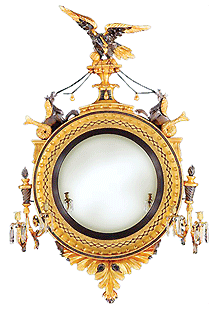 In England the period of 1811-1820 which was the period of Prince of Wales (later known as George IV) who acted as regent during his father's period of insanity is generally defined as the Regency period. But as with any period of style, the styles and fashions of the Regency were not confined to that specific decade. The influence of the Prince made itself felt long before he took temporary control from his father in 1811, and certainly did not disappear when he became king in 1820. However, as a furniture style, Regency has come to embrace a wider time frame, from the 1790's to the third decade of the 19th century.
In England the period of 1811-1820 which was the period of Prince of Wales (later known as George IV) who acted as regent during his father's period of insanity is generally defined as the Regency period. But as with any period of style, the styles and fashions of the Regency were not confined to that specific decade. The influence of the Prince made itself felt long before he took temporary control from his father in 1811, and certainly did not disappear when he became king in 1820. However, as a furniture style, Regency has come to embrace a wider time frame, from the 1790's to the third decade of the 19th century.
No style is more aptly named than Regency, for unlike most styles that bear the name of a current ruler, Regency has at its heart the tastes of the Prince Regent himself. The Prince became Regent in 1811.He was responsible for the building of Regent Street and Cumberland Terrace. He spent in three 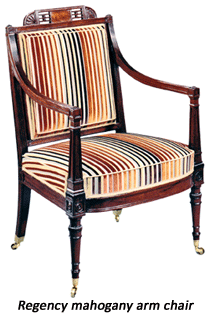 years almost a fortune of £160,000 on furniture alone; he was an avid collector of Dutch masters, porcelain and furniture. The Prince presided over the rebuilding of much of central London, with possibly his most impressive achievement being Carlton House given to the Prince of Wales when he came of age in 1783. With the help of the three architects Henry Holland (1745-1806), James Wyatt (1746-1813) and John Nash (1752-1835), he transformed a relatively modest two-storied house into a veritable palace worthy of comparison to European royal retreats. Regency high style at its most sumptuous was embodied here.
years almost a fortune of £160,000 on furniture alone; he was an avid collector of Dutch masters, porcelain and furniture. The Prince presided over the rebuilding of much of central London, with possibly his most impressive achievement being Carlton House given to the Prince of Wales when he came of age in 1783. With the help of the three architects Henry Holland (1745-1806), James Wyatt (1746-1813) and John Nash (1752-1835), he transformed a relatively modest two-storied house into a veritable palace worthy of comparison to European royal retreats. Regency high style at its most sumptuous was embodied here.
The decoration and furnishings of Carlton House were said to be the Prince's most impressive achievement, but some commentators thought Brighton Pavilion reflected the Princes personality more accurately. The project was a product of the collaboration between the Prince and Henry Holland; it was a lavish oriental fantasy with onion-shaped domes and Moorish arches, pierced stone facades and tall arched windows. Brighton House (eventually to be renamed Brighton Pavilion), was partially rebuilt between 1815 and 1822 when the Prince became interested in the taste for Chinoiserie, then fashionable again. He commissioned designs for a new building in the Oriental style. Several eminent architects submitted drawings, but the final result was the work of John Nash. The Prince was ecstatic with the results and was to furnish and decorate his pride and joy in exuberant style. He had the walls decorated with mandarins and fluted yellow draperies to resemble Chinese tents, the ceilings hung with canopies of tassels and bells and Oriental treasures of all kinds. 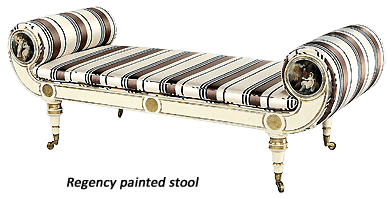 A large proportion of the furniture was made in England in the Chinese manner and carved and painted to simulate bamboo. George Smith (1756-1826) and Thomas Hope (1769-1831) were two furniture designers for the Royal Pavilion then named before Brighton Pavilion.
A large proportion of the furniture was made in England in the Chinese manner and carved and painted to simulate bamboo. George Smith (1756-1826) and Thomas Hope (1769-1831) were two furniture designers for the Royal Pavilion then named before Brighton Pavilion.
The major source of inspiration for Regency taste was found in Greek and Roman antiquity, from which designers borrowed both structural and ornamental elements. The classical revival of Regency style, emphasizing purity of detail and structure, adhered to a stricter archaeological interpretation of antique modes than either the Neoclassicism of the 18th century or the concurrent French Empire style. An exuberant taste for Egyptian motifs resulted from the Napoleonic expeditions to Egypt in 1798 and became part of the Regency fashion. 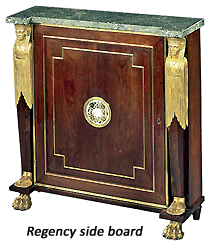 Variations in the Regency period also produced a resurgence of the Chinese theme seen in imitation bamboo and in painted and "japanned" black and gold lacquer pieces, most notably at Brighton Pavilion, where the Prince ordered its use. Another royal inclination produced the taste for French furniture, especially the type ornamented with brass inlay marquetry. A later trend foreshadowed the Victorian styles to follow. The elaboration of ornament on the flat surfaces of Regency furniture derived from the rich contrast of exotic wood veneers and application of metals or painting rather than extensive carving or complicated contours. A strong feeling for utility combined with visually pleasing elements and an integration of architecture, interior design, and furniture is characteristic.
Variations in the Regency period also produced a resurgence of the Chinese theme seen in imitation bamboo and in painted and "japanned" black and gold lacquer pieces, most notably at Brighton Pavilion, where the Prince ordered its use. Another royal inclination produced the taste for French furniture, especially the type ornamented with brass inlay marquetry. A later trend foreshadowed the Victorian styles to follow. The elaboration of ornament on the flat surfaces of Regency furniture derived from the rich contrast of exotic wood veneers and application of metals or painting rather than extensive carving or complicated contours. A strong feeling for utility combined with visually pleasing elements and an integration of architecture, interior design, and furniture is characteristic.
The designs of George Heppelwhite who died in 1786 and Thomas Sheraton (1751-1806) are worth mentioning in the context of English Regency furniture. There were also a number of contemporary designers who were to play an important part in its future development. One of the most notable was Thomas Hope who as previously mentioned worked on the Brighton Pavilion. Hope brought a scholar's adaptation of Greek and Egyptian ornament into English furniture design. Hope first introduced his ideas in his Household Furniture and Interior Decoration published in 1807. Another important Regency personality was Nelson (1758-1805). 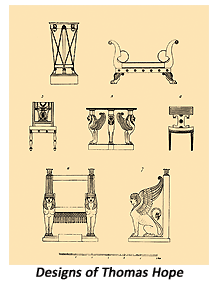 Admiral Nelson's much publicized victories at sea had a powerful effect on English Regency furniture design. Ebony was used to decorate furniture as a sign of mourning, and some chairs were carved in imitation of Nelson's draped sarcophagus. Seafaring motifs abounded, their best-known use is on Sheraton's 'Nelson chair', or 'Trafalgar Chair', which has decorations of carved dolphins, anchors and rope on the splat.
Admiral Nelson's much publicized victories at sea had a powerful effect on English Regency furniture design. Ebony was used to decorate furniture as a sign of mourning, and some chairs were carved in imitation of Nelson's draped sarcophagus. Seafaring motifs abounded, their best-known use is on Sheraton's 'Nelson chair', or 'Trafalgar Chair', which has decorations of carved dolphins, anchors and rope on the splat.
The wood used for furniture during the Regency period was darker and heavier, mahogany was used either solid or veneered. Rosewood became very fashionable wood for cabinetwork after 1800 and many Regency pieces were made entirely of it. Satin wood was still used, especially during the early phase of Regency Style. Other exotic wood such as ebony and zebra wood were used combined with Brass inlays. Metal mounts and metal inlays were prevailing fashion for decorating the surface of the Regency furniture. Metal mounts such as rosettes, paterae, bosses and anthemion palmettes, female masks and lion masks were used on the furniture as applied decorations. Brass inlays were cut from Brass sheets. Rosewood and mahogany furniture were frequently inlaid with narrow banding and stringing lines either with contrasting wood or with brass. Furniture was also sometimes decorated with scrollwork, and with foliated ornament cut from brass. Other metal features such as metal moldings, pierced galleries and metal paw feet on the legs of chairs and tables were used. Sometimes the brass colonettes and balusters as supports for shelves, and also freestanding fluted colonettes were used. The cabinet doors were often filled with brass trellis work, backed by silk curtains. 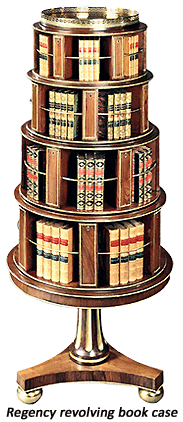 The handles for the cabinet doors and the drawer pulls were either bronze or brass knob handles, plain or ornamental. Sometimes the handles were loose rings with lion masks. As a result of the frequent use of metal mounts very little carved details were used on the furniture. Even the carved detail when used was finished in gilt or bronze paint to simulate the fashionable metal mounts. The style of classic ornament used by the Regency designers was characterized by the symmetry of its composition. The ornament borrowed from the antique Greek and Roman sources was cold, stiff and formal. Most frequently ornaments from the classical antiquity used were archaic lion masks, lion monopodium, lion and other paw feet, caryatids, swans and dolphins, etc.
The handles for the cabinet doors and the drawer pulls were either bronze or brass knob handles, plain or ornamental. Sometimes the handles were loose rings with lion masks. As a result of the frequent use of metal mounts very little carved details were used on the furniture. Even the carved detail when used was finished in gilt or bronze paint to simulate the fashionable metal mounts. The style of classic ornament used by the Regency designers was characterized by the symmetry of its composition. The ornament borrowed from the antique Greek and Roman sources was cold, stiff and formal. Most frequently ornaments from the classical antiquity used were archaic lion masks, lion monopodium, lion and other paw feet, caryatids, swans and dolphins, etc.
Among the Regency furniture pieces chairs were very popular and still the regency style reflects in the modern interpretation of the chairs especially the dining chairs. Typical features of Regency chairs are the horizontal lines, saber or concave front legs, high set arms on the back uprights and backward sweep of the top rail forming a continuous curve with the rear legs. The crest rails are broad and flat, often making use of the archaeological motif drawn from the Egyptian, Greek and Roman civilization. Chairs with a low back, rolled-over uprights, saber or concave front legs were especially fashionable, and were usually made of rosewood or mahogany. In the spirit of imitating the antique, chairs of ancient curule or X-form with uprights and legs terminating in archaic animal heads and feet were also made. Straight tapered legs of either quadrangular or cylindrical form were also used and were frequently finely reeded. Stringing lines, foliated patterns and paterae of brass largely replaced the carved, inlaid or painted decoration employed in the 18th century. 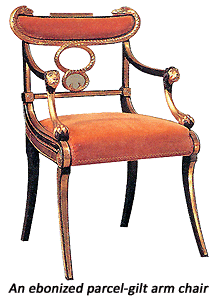 Beside chairs there were other pieces of furniture like stools, beds, tables, commodes, chest of drawers etc. Sofa and couches were very important examples of Regency style, particularly the couch was the creation of Regency style which could be used as day-bed, still popular in the present times. Mirrors and accessories were also popular, circular mirrors along with convex mirrors in gilded frame were widely used.
Beside chairs there were other pieces of furniture like stools, beds, tables, commodes, chest of drawers etc. Sofa and couches were very important examples of Regency style, particularly the couch was the creation of Regency style which could be used as day-bed, still popular in the present times. Mirrors and accessories were also popular, circular mirrors along with convex mirrors in gilded frame were widely used.
A rich mix of both foreign and home-grown designs influenced the design of British furniture during the Regency period. From Mogul domes to Islamic arches, Regency designers drew inspiration from motifs in ancient Egypt, chinoiserie from China and Pierced Jalies in stones from India. The interest in India manifested itself more in the importation of western-style furniture than the application of Indian motifs in British furniture. Exotic ivory-inlaid rosewood furniture and boxes were supplied from southern India and ebony chairs in Regency style from Ceylon. In conclusion, it can be fairly said that the influence of Regency forms and its interpretation of the classical motifs are still a source of inspiration for the modern furniture designers.